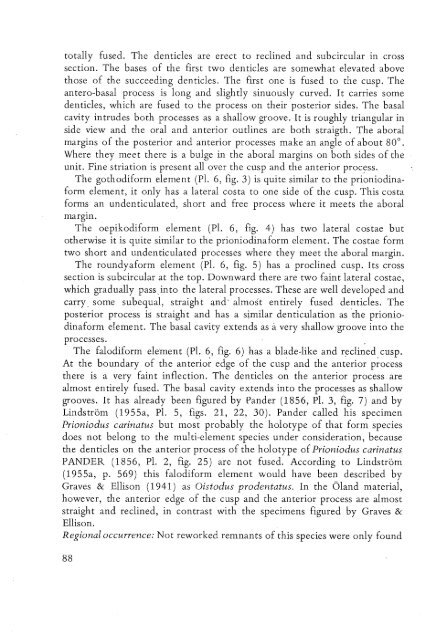UTRECHT MICROPALEONTOLOGICAL BUllETINS
UTRECHT MICROPALEONTOLOGICAL BUllETINS
UTRECHT MICROPALEONTOLOGICAL BUllETINS
You also want an ePaper? Increase the reach of your titles
YUMPU automatically turns print PDFs into web optimized ePapers that Google loves.
totally fused. The denticles are erect to reclined and subcircular in cross<br />
section. The bases of the first two denticles are somewhat elevated above<br />
those of the succeeding denticles. The first one is fused to the cusp. The<br />
antero-basal process is long and slightly sinuously curved. It carries some<br />
denticles, which are fused to the process on their posterior sides. The basal<br />
cavity intrudes both processes as a shallow groove. It is roughly triangular in<br />
side view and the oral and anterior outlines are both straigth. The aboral<br />
margins of the posterior and anterior processes make an angle of about 80°.<br />
Where they meet there is a bulge in the aboral margins on both sides of the<br />
unit. Fine striation is present all over the cusp and the anterior proc~ss.<br />
The gothodiform element (PI. 6, fig. 3) is quite similar to the prioniodinaform<br />
element, it only has a lateral costa to one side of the cusp. This costa<br />
forms an undenticulated, short and free process where it meets the aboral<br />
margin.<br />
The oepikodiform element (PI. 6, fig. 4) has two lateral costae but<br />
otherwise it is quite similar to the prioniodinaform element. The costae form<br />
two short and undenticulated processes where they meet the aboral margin.<br />
The roundyaform element (PI. 6, fig. 5) has a proclined cusp. Its cross<br />
section is subcircular at the top. Downward there are two faint lateral costae,<br />
which gradually pass)nto the lateral processes. These are well developed and<br />
carry some subequal, straight and' almost entirely fused denticles. The<br />
posterior process is straight and has a similar denticulation as 'the prioniodinaform<br />
element. The basal cavity extends as a very shallow groove into the<br />
processes. .<br />
The falodiform element (PI. 6, fig. 6) has a blade-like and reclined cusp.<br />
At the boundary of the anterio~ edge of the cusp and the anterior p~ocess<br />
there is a very faint inflection. The denticles on the anterior process are<br />
almost entirely fused. The basal cavity extends into the processes as shallow<br />
grooves. It has already been figured by Pander (1856, PI. 3, fig. 7) and by<br />
Lindstrom (1955a, PI. 5, figs. 21, 22, 30). Pander called his specimen<br />
Prioniodus carinatus but most probably the holotype of that form species<br />
does not belong to the multi-element species under consideration, because<br />
the denticles on the anterior process of the holotype of Prioniodus carinatus<br />
PANDER (1856, PI. 2, fig. 25) are not fused. According to Lindstrom<br />
(1955a, p. 569) this falodiform element would have been described by<br />
Graves & Ellison (1941) as Oistodus prodentatus. In the bland material,<br />
however, the anterior edge of the cusp and the anterior process are almost<br />
straight and reclined, in contrast with the specimens figured by Graves &<br />
Ellison.<br />
Regional occurrence: Not reworked remnants of this species were only found
















